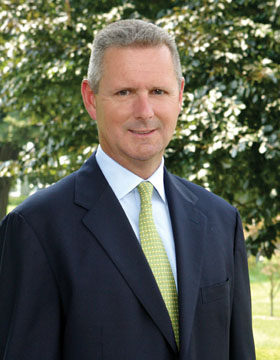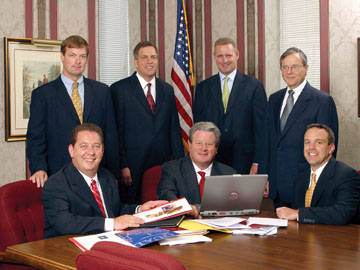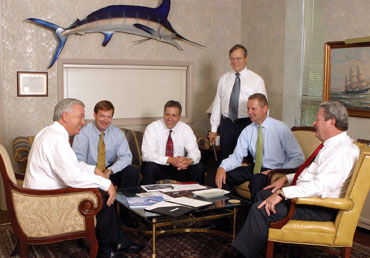BOLD MOVES
Braishfield Associates forms insurance company
to serve Florida homeowners market
By Phil Zinkewicz
 |
“We wanted to do more than solve our immediate capacity problem …
We were determined to build a high-quality, financially stable insurer that would be a reliable market for agents and their customers over the long haul.”
— Jim McCahill
President/CEO, Braishfield Associates, Inc.
Chairman, St. Johns Insurance Company |
What does a man do when he’s happy at his job, flourishing in his career, enjoying pleasant relationships with co-workers, is being amply rewarded and is comfortable in his surroundings? Why, he quits, of course. He uproots his family, moves to a new location and takes a job with a firm that is in shaky financial condition and in danger of foundering.
That’s exactly what James J. McCahill (Jim) did roughly 14 years ago when he left a secure position at the Savannah, Georgia, office of Palmer & Cay, the large, regional retail insurance broker, to take a job as the number two person in the Clifton, New Jersey-based Braishfield Associates, Inc. Today, Braishfield is a well-respected managing general agency (MGA) and program designer and administrator; but back in the early 1990s, when McCahill joined the firm, it seemed to many in the business that he was jumping aboard a sinking ship.
“Braishfield was established as a retail agency in 1984 by Louis J. Kennedy, a New Jersey entrepreneur in the trucking business,” says McCahill. “Kennedy’s original concept was that he would hire some of the top talent from the alphabet houses in the Northeast. He acquired this talent by offering fairly aggressive compensation packages. The operation began in New York but, by 1986, they had offices also in Clifton, Boston and Philadelphia. In a few short years, Braishfield had established a very impressive client list comprising Fortune 500 companies—Toys R Us and Pepsi Cola, among others. Braishfield represented all major insurance markets and offered a viable alternative to the alphabet brokers, which dominated the market in the late 1980s.”
 |
Braishfield executives are (seated left to right) Neil Biscuiti, Senior Vice President and Sales Director; Reese Bowen, Senior Vice President; and Andrew Anderson, Vice President; and (standing left to right) Robert Lucas, Chief Operating Officer and Executive Vice President; Fred Cieslak, Senior Vice President and Orlando Branch Manager; James McCahill, President and Chief Executive Officer; and Edward Falzarano, Chief Financial Officer. |
However, the company’s performance did not match corporate expectations, according to McCahill. “Braishfield lost large sums of money and most of that money came out of Kennedy’s pocket,” he says. “One poor decision was made after another. The firm began to lose company markets. Morale became very low and, by the late 1980s, the word on the street was that the company was dying. Still, Kennedy refused to quit.”
McCahill was at Palmer & Cay at the time. “At the age of 33, I was secure in my position as a principal and director of commercial operations. It was a blue-chip organization, with some 400 employees. The people were talented and friendly. I loved the city of Savannah. Everything was wonderful. Still, a little voice inside me was telling me that I could do more. I learned of Braishfield and its difficulties, and I knew they were looking for someone to fill the number two spot. I met with Kennedy, who was a man of integrity and fortitude. He was also very persuasive. I shook hands with him, picked up my family and moved to New Jersey.”
After spending only one year in the number two spot, McCahill became president/CEO of Braishfield in 1991. The property and casualty market was soft at the time. Because of the company’s bad financials, company markets began to lose faith in the agency.
“I was able to get company markets for the agency to represent because of my years with Palmer & Cay and the relationships I had built up.” says McCahill. “We streamlined operations by closing the Boston and New York offices and scaled down the Philadelphia operations. By the third quarter of 1991, we had stability in the marketplace.”
In 1991, Braishfield was “tribunalized” at Lloyd’s of London, and the firm had binding authority for property coverages launched on a retail/wholesale basis. This in itself is interesting because, in 1991, Lloyd’s was in the midst of severe litigation problems stemming from investor dissatisfaction. Many in the industry were predicting the market’s demise, but McCahill bucked the trend and, once again, jumped aboard. “I simply could not believe that Lloyd’s, with its 350-year history of superior performance, would fall. So, we established a relationship with Lloyd’s that stands strong today.”
By this time, Braishfield was on its way up once again. In 1992, Braishfield established a Florida branch in Melbourne. A year later, the MGA created an underground storage tank program called PLUS (Pollution Liability U.S.), underwriting pollution coverage on behalf of Zurich American. In 1994, Braishfield created a condominium program called WRAP, with insurers Continental, Chubb and The Hartford Steam Boiler, offering primary insurance, umbrella and equipment breakdown, respectively. The SSIP (Service Station Insurance Program) was created in 1996 and it gained the endorsement of the New Jersey Gasoline Retailers Association (NJGRA). Later, the firm obtained the endorsement of similar associations in Pennsylvania, Florida and New York. Also in 1996, Braishfield created a 13-state Homeowners Program for a major direct writer with General Star, Lloyd’s and Caliber One as carriers.
In 1997, Braishfield took another major step. It divested its retail business to focus exclusively on program business. “We had built an excellent team,” says McCahill. “Mike Hoagland has a 30-year history in the insurance business, having worked at Aetna, Johnson & Higgins, W. Andrus Insurance and North American Underwriters. Robert P. Lucas has extensive experience in underwriting program business and large accounts. He began his career with Chubb. Michael Culbertson is our expert in crafting strategic market alliances and creating our claims handling subsidiary, Insurance Network Services. This is a team that’s hard to beat.”
Over the years, Braishfield has created its Mobile Home Program, Hurricane Deductible Buydown Program, two workers compensation programs and two commercial property/casualty programs for independent agents and direct writers, among others.
However, it was just last year that McCahill took what may prove to be the greatest risk of his career. He started up a new insurance company in Florida to write homeowners insurance, naming it St. Johns Insurance Company.
The move is a gutsy one considering the current state of the Florida insurance market. There are few insurers these days that target the Florida homeowners market. And, according to McCahill, few of those want to increase their market share. They perceive the risks as simply too great. Florida has more miles of coastline than any state in the continental United States. The concentration of population, high-rises and other construction in southeast Florida is unmatched. One out of every three hurricanes that strike the United States makes landfall in Florida. Fifty-five percent of every dollar paid for hurricane damage in the United States has been paid in Florida. And, of course, the state will long be remembered by many as the scene of Hurricane Andrew, the most expensive natural catastrophe event in U.S. history, totaling $16 billion in losses.
“When we talk about the Florida market these days, we refer to ‘pre-Andrew’ and ‘post-Andrew,’” says McCahill. “Prior to Hurricane Andrew, insurers were competing aggressively for coastline business, not only in Florida, but in other parts of the country as well. But, after Andrew, insurers began to shun coastline business until they had the time to reassess the risks involved. Today, insurers and reinsurers all over the world are more sophisticated in assessing their catastrophe exposures.”
Nevertheless, while insurers may not be all that excited about writing homeowners business in Florida, a growing number of Americans, especially retirees, are choosing Florida as their destination of choice. The residential real estate market is exploding with 150,000 new homes being built each year. Therefore, the decreasing presence of insurers and the increasing number of homes to be insured have created a capacity crunch, with 806,561 policies currently written through the state-sponsored Citizens Property Insurance Corp.—the market of last resort.
“The enormous need in Florida, coupled with the shortage of capacity has resulted in frustration across the board,” McCahill explains. “The usual forces of supply and demand have been upended, so that the Citizens has become the fastest growing market in the state.”
McCahill says he has experienced the high level of frustration first hand. Braishfield has been developing and managing homeowners programs for blue-chip insurers in Florida since 1992. As a program manager, Braishfield’s job is to deliver the product to agents and produce profits for insurers. Even though the firm had a solid, well-performing book of 70,000 homeowners policies, there was a shortage of quality carriers willing to step up to the plate and write Braishfield’s growing book of business.
According to McCahill, after September 11, an already tough market got a whole lot tougher. Braishfield lost two of its key markets—-one of which was due to the redeployment of the windstorm aggregate at Lloyd’s. McCahill and his management team realized they couldn’t afford to rely on the existing markets. They had two choices: fall victim to the marketplace or take control of their destiny.
“We wanted to do more than solve our immediate capacity problem,” said McCahill. “For us, this was a long-term play. Through the years, we had seen the damage done by carriers that lacked the commitment, underwriting expertise, discipline and resources to succeed, and by those who merely wanted to leverage short-term financial opportunities in the marketplace. We were determined to build a high-quality, financially stable insurer that would be a reliable market for agents and their customers over the long haul. We built our systems and business plan around distribution of risk and penetrating regions, which many of the new ‘special purpose’ companies could not.”
And that’s how St. Johns was born. McCahill admits the idea of starting an insurance company was intimidating. Being a program administrator that did the underwriting for insurers, Braishfield possessed the management, underwriting, product design and technology expertise, but no one in the firm had ever started or run an insurance company before. Even though the firm was profitable and growing, according to McCahill, it was clear that a new venture of this magnitude would require outside investors and a significant investment of capital.
 |
Executives of the The St. Johns Insurance Company, which was formed to write Braishfield’s growing book of business in Florida, are (left to right) Mike Hoagland, President; Robert Lucas, Director; Fred Cieslak; Ed Falzarano; James McCahill, St. Johns Chairman; and Reese Bowen, Chief Underwriting Officer. |
McCahill was keenly aware of the slim odds against attracting capital, so he focused on strategic business partners who had a vested interest in seeing the new venture succeed.
“The principal reason potential investors didn’t laugh us out of the room was the quality of our data. We had religiously maintained our data over the years as the basis of our homeowners pricing, spread of risk and probable maximum loss (PML) modeling. The homeowners book of business we’d built in Florida proved the validity of our approach and the professionalism of our agency distribution network. We also had the support of a first-rate team from AON Re. They believed in our plan and worked side by side with us, without compensation, when St. Johns was still a long shot. AON has placed all of our reinsurance with blue chip reinsurers.”
Still, investors were somewhat wary of a start-up operation in such a volatile environment. Braishfield management spent 15 months telling its story and getting the new company off the ground. McCahill says that the “deal died” numerous times during that period, but he and his team refused to give up the dream. “I’ve learned from some of the best—including Lloyd’s of London—that insurance is about taking a calculated risk and rushing in where others fear to tread. We believed strongly that good numbers, good information, good people and a good plan ought to spell insurance opportunity. That’s what I’ve been taught. Fortunately, others believed in us.”
McCahill’s tenacity paid off. Through a combination of debt and equity, the company raised the $12.5 million they needed to launch St. Johns. In December 2003, St. Johns received approval from the Florida Insurance Department and opened their first office in Orlando.
McCahill’s outlook for the future is positive. He sees strong potential for profitable growth in Florida. “St. Johns has a number of strategic advantages,” he says. “Unlike many Florida start-ups, we aren’t saddled with a book of business depopulated from the state underwriting facility. Our book is 100% voluntary. We have the benefit of favorable rate filings. The Florida Insurance Department has been tough, but we have definitely received approvals that are to our benefit. Demotech, a nationally-recognized rating service agency that analyzes and rates regional property and casualty insurance companies for financial strength, has given St. Johns an ‘A’ Exceptional rating, which reflects exceptional financial stability related to maintaining positive surplus as regards policyholders. Also, we don’t have the legacy of past claims to deal with. Another advantage is the caliber of our agency force and the breadth of our statewide distribution system. Equally important, we have the top-notch technology we need to process low margin business quickly and cost-efficiently. In addition, we have exceptional business partners and a proven and trusted team.”
Since its beginning, St. Johns has written a total of 6,000 policies and is averaging 100 a day. The company anticipates writing somewhere between 30,000 and 50,000 policies by year-end. “Agents recognize that St. Johns brings more to the table than capacity,” says McCahill. “It doesn’t take long for agents to see that we understand where they’re coming from. We know their problems, and we’ve lived their frustrations. The respect and appreciation we have for the agents’ point of view comes through loud and clear.”
So that’s where Braishfield stands today. McCahill, 14 years ago, heard a siren’s call that lured him away from a steady, secure and well-respected job and towards the challenges and opportunities that Braishfield presented. And, he attributes his success to hard work, a willingness to do what you intend to do and “a little Irish insanity.” *


